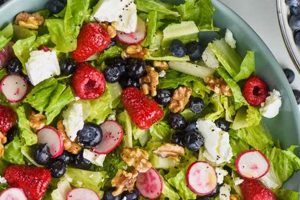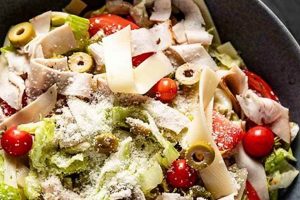A classic Caesar salad typically includes romaine lettuce, croutons, Parmesan cheese, and a dressing made with ingredients such as egg yolks, lemon juice, garlic, olive oil, and Worcestershire sauce. The traditional recipe also calls for anchovy paste or fillets, contributing a savory, umami depth to the dressing. Omitting this ingredient creates a variation suitable for those who dislike anchovies or prefer a milder flavor profile. This adaptation maintains the core elements of the salad while offering a more accessible taste.
This anchovy-free version broadens the appeal of the Caesar salad, making it enjoyable for a wider range of palates. It allows individuals with dietary restrictions related to fish or shellfish to experience this culinary staple. Furthermore, removing anchovies simplifies the preparation process for home cooks, as it eliminates the need for a specialized ingredient that may not be readily available. While the traditional recipe has its historical significance, originating in Tijuana, Mexico, this modern adaptation offers a practical and delicious alternative.
The following sections will explore various aspects of preparing an excellent anchovy-free Caesar salad, including ingredient selection, dressing preparation techniques, crouton variations, and presentation suggestions. Readers will learn how to create a flavorful and satisfying salad tailored to their preferences.
Tips for an Excellent Anchovy-Free Caesar Salad
Achieving a delicious Caesar salad without anchovies requires attention to detail and quality ingredients. These tips offer guidance for creating a flavorful and satisfying experience.
Tip 1: Emulate Umami: While anchovies provide a distinct umami flavor, it can be replicated using other ingredients. Consider incorporating a small amount of Worcestershire sauce (ensure it’s vegetarian if needed), a dash of soy sauce, or a pinch of nutritional yeast to achieve a similar savory depth.
Tip 2: Freshly Grated Parmesan: Pre-grated Parmesan often contains cellulose which can hinder melting and flavor. Opt for a block of high-quality Parmesan and grate it freshly for the best texture and taste.
Tip 3: Homemade Croutons: Elevate the salad with homemade croutons. Cube day-old bread, toss with olive oil, herbs, and spices, and bake until golden brown and crispy.
Tip 4: Proper Romaine Preparation: Wash and thoroughly dry the romaine lettuce to prevent a watery dressing. Tear the leaves into bite-sized pieces.
Tip 5: Garlic Infusion: Infuse the olive oil for the dressing with a clove of garlic for a subtle, yet impactful garlicky flavor. Gently heat the oil with the garlic clove, then remove the garlic before whisking the dressing.
Tip 6: Lemon Juice Freshness: Freshly squeezed lemon juice provides a brighter, more vibrant flavor compared to bottled lemon juice. Adjust the amount to achieve the desired tartness.
Tip 7: Egg Safety: If using raw egg yolks in the dressing, ensure they are pasteurized or coddled to minimize the risk of foodborne illness. Alternatively, use a recipe that omits raw eggs entirely.
By following these tips, one can create a Caesar salad that rivals the traditional version, even without anchovies. The focus on fresh ingredients and balanced flavors ensures a delightful culinary experience.
These techniques provide a foundation for crafting a personalized Caesar salad experience. The following section concludes with variations and serving suggestions.
1. Romaine Lettuce
Romaine lettuce serves as the foundational ingredient in a Caesar salad, regardless of the presence or absence of anchovies. Its crisp texture and slightly bitter flavor profile provide a refreshing counterpoint to the richness of the dressing and the sharpness of the Parmesan cheese. The structural integrity of romaine’s leaves allows them to hold the dressing without becoming soggy, ensuring a pleasant eating experience. Other lettuce varieties, such as iceberg or butter lettuce, lack the same textural resilience and flavor complexity necessary for a successful Caesar salad. Attempting to substitute romaine often results in a compromised final product, lacking the characteristic balance and satisfying crunch.
Historically, the original Caesar salad featured whole romaine leaves, meant to be eaten with the fingers. Modern preparations typically involve chopping or tearing the romaine into bite-sized pieces. This adaptation makes the salad easier to manage and allows for more even distribution of the dressing and other components. However, the choice between whole leaves and chopped romaine remains a matter of personal preference and presentation style. Regardless of the preparation method, the inherent qualities of romaine lettuce remain essential to the overall success of the dish, providing a refreshing, crisp foundation that complements the other ingredients.
Selecting high-quality romaine is crucial. Look for heads with vibrant green leaves, free from browning or wilting. Proper storage, in a cool, dry environment, helps maintain freshness. The distinct flavor and textural contribution of romaine lettuce underscores its irreplaceable role within the Caesar salad, even in variations omitting anchovies. Its presence remains central to achieving the desired balance and satisfying culinary experience characteristic of this classic dish.
2. Croutons
Croutons contribute a crucial textural element to a Caesar salad, especially in variations without anchovies. Their crispness contrasts with the crisp romaine and provides a satisfying counterpoint to the creamy dressing and the hard Parmesan cheese. The absence of anchovies, which offer a briny, intense flavor, places greater emphasis on the textural interplay within the salad, highlighting the importance of well-executed croutons. A Caesar salad lacking properly prepared croutons often feels incomplete, especially when the assertive flavor of anchovies is also absent. For example, a salad with stale or soft croutons diminishes the overall eating experience, impacting both the texture and the absorption of the dressing.
The preparation method significantly influences the quality of the croutons. Homemade croutons, crafted from day-old bread and seasoned appropriately, offer superior flavor and texture control compared to store-bought alternatives. Cubing the bread into uniform sizes ensures even toasting and prevents uneven texture within the salad. Tossing the bread cubes with olive oil, herbs, and spices before baking creates a flavorful and aromatic component that enhances the overall salad experience. Furthermore, the baking process itself allows for control over the level of crispness, achieving the ideal balance between crunchy and delicate. For instance, croutons seasoned with garlic powder, dried oregano, and a touch of salt complement the other flavors in a Caesar salad without overpowering the delicate balance achieved in the absence of anchovies.
Achieving optimal crouton texture involves using appropriate bread types and employing proper baking techniques. Day-old bread, slightly dried, yields crispier croutons as excess moisture has evaporated. Avoid using overly soft breads or breads with high sugar content, as these tend to produce less desirable results. Baking at the correct temperature for the appropriate duration ensures even browning and avoids burning. The goal is to achieve a golden-brown color and a crisp, yet not rock-hard, texture. These considerations, coupled with mindful seasoning, elevate the role of croutons in a Caesar salad without anchovies, compensating for the missing salty, umami notes typically provided by the fish. The croutons, therefore, become an even more integral part of the dish, adding a depth of flavor and textural complexity essential for a satisfying and balanced culinary experience.
3. Parmesan Cheese
Parmesan cheese plays a crucial role in a Caesar salad, particularly when anchovies are omitted. Its sharp, salty, and umami-rich flavor profile compensates for the missing briny, savory notes typically provided by the fish. The hard texture of Parmesan also contributes a significant textural element, contrasting with the crisp romaine and croutons, and balancing the creamy dressing. Understanding the various aspects of Parmesan’s contribution to this specific variation of Caesar salad enhances appreciation for its importance in achieving a balanced and flavorful dish.
- Flavor Enhancement
Parmesan’s complex flavor profile, characterized by sharpness, saltiness, and umami notes, becomes even more prominent in a Caesar salad without anchovies. It adds depth and complexity, balancing the other ingredients. The absence of anchovies allows the nuanced flavors of the cheese to shine, contributing a savory dimension that might otherwise be overshadowed. For example, the nutty and slightly sweet undertones of aged Parmesan become more noticeable, adding layers of flavor to the salad.
- Textural Contrast
The hard, granular texture of Parmesan provides a crucial textural counterpoint to the other components of the salad. It contrasts with the crisp romaine lettuce and croutons, creating a more dynamic and satisfying mouthfeel. The absence of the soft, briny texture of anchovies further emphasizes the importance of Parmesan’s textural contribution. The interplay of crisp and hard textures elevates the eating experience, making each bite more engaging.
- Umami Contribution
Parmesan, like anchovies, contains glutamates, which contribute to its umami flavor. In a Caesar salad without anchovies, Parmesan becomes a primary source of this savory, fifth taste. This umami richness adds depth and complexity, compensating for the missing umami notes typically provided by the fish. The reliance on Parmesan for umami underscores its importance in achieving a well-rounded flavor profile.
- Quality Considerations
The quality of Parmesan significantly impacts the overall flavor and texture of the salad. Freshly grated Parmesan, from a block of high-quality cheese, offers superior flavor and texture compared to pre-grated alternatives. Pre-grated Parmesan often contains cellulose, which can hinder melting and negatively affect the flavor. Investing in high-quality Parmesan ensures optimal flavor and texture, maximizing its contribution to the salad, especially in the absence of anchovies.
In a Caesar salad without anchovies, Parmesan cheese takes on an even more significant role, contributing essential flavor, texture, and umami. Its presence elevates the salad from a simple combination of ingredients to a complex and satisfying culinary experience. The careful selection and proper handling of Parmesan ensure that its full potential is realized, creating a balanced and flavorful dish that stands on its own, even without the traditional inclusion of anchovies.
4. Anchovy-Free Dressing
Anchovy-free dressing constitutes the defining characteristic of a Caesar salad recipe without anchovies. It replaces the traditional Caesar dressing, which typically incorporates anchovies or anchovy paste, offering a milder, fish-free alternative. Understanding the components and formulation of this dressing is crucial for replicating the flavor profile and textural experience of a Caesar salad while accommodating dietary preferences or ingredient availability limitations.
- Emulating Umami
Traditional Caesar dressing derives a significant portion of its umami flavor from anchovies. Anchovy-free versions must compensate for this absence. Common strategies include incorporating ingredients like Worcestershire sauce (vegetarian versions are available), soy sauce, or nutritional yeast. These ingredients provide savory depth, mimicking the umami contribution of anchovies without introducing a fishy taste. Balancing these umami-rich alternatives is essential to avoid overpowering the other flavors in the dressing.
- Balancing Acidity and Richness
The balance between acidity and richness is crucial in any Caesar dressing. Lemon juice provides the primary acidic component, balancing the richness of the egg yolks and olive oil. In an anchovy-free version, this balance becomes even more critical, as the absence of anchovies removes a layer of salty, savory complexity. Careful adjustment of lemon juice ensures the dressing provides the necessary brightness without becoming overly tart. Additionally, the quality of the olive oil contributes to the overall richness and flavor of the dressing.
- Textural Considerations
Traditional Caesar dressing often incorporates the finely minced or pureed texture of anchovies. Anchovy-free versions must achieve a comparable creamy consistency without this element. Emulsification, achieved by vigorously whisking together the ingredients, creates a smooth and creamy texture that coats the romaine lettuce effectively. The use of egg yolks contributes to the emulsification process and adds richness to the dressing. Achieving the right texture is essential for a pleasant eating experience.
- Ingredient Quality
As with any culinary endeavor, the quality of the ingredients directly impacts the final result. Freshly squeezed lemon juice offers superior flavor compared to bottled varieties. High-quality olive oil contributes desirable flavor and texture. Freshly grated Parmesan cheese, when included in the dressing, enhances both flavor and texture. Attention to ingredient quality elevates the overall taste and experience of the anchovy-free Caesar salad.
The careful consideration of umami, acidity, richness, texture, and ingredient quality allows for the creation of an anchovy-free Caesar dressing that successfully replicates the essential characteristics of the classic dressing while catering to dietary restrictions and preferences. This adaptation ensures that the Caesar salad remains a versatile and enjoyable dish for a wider range of individuals, preserving its essence while offering flexibility in its preparation.
5. Umami Alternatives
Umami, the savory fifth taste, plays a crucial role in the flavor profile of traditional Caesar salad, primarily derived from anchovies. In recipes omitting anchovies, achieving a comparable umami depth requires careful consideration of alternative ingredients. These alternatives provide the savory complexity necessary for a satisfying and balanced flavor profile without relying on fish-based ingredients. Exploring these alternatives allows for a broader understanding of umami’s role in this classic dish and expands the possibilities for customization and dietary accommodation.
- Worcestershire Sauce
Worcestershire sauce, despite containing anchovies in its traditional formulation, offers readily available vegetarian alternatives. These versions replicate the savory, umami-rich character of the original sauce without introducing fish. The complex blend of ingredients, including soy sauce, vinegar, molasses, and various spices, contributes a depth of flavor that enhances the Caesar dressing. The concentrated nature of Worcestershire sauce necessitates careful portioning to avoid overpowering the other flavors.
- Soy Sauce
Soy sauce, a fermented soybean product, provides a readily available and cost-effective source of umami. Its salty and savory characteristics complement the other ingredients in the Caesar dressing, adding depth and complexity. Different varieties of soy sauce, such as tamari or light soy sauce, offer subtle flavor variations. Like Worcestershire sauce, moderation is key to prevent excessive saltiness.
- Nutritional Yeast
Nutritional yeast, a deactivated yeast product, offers a unique cheesy, nutty flavor profile with inherent umami notes. It provides a vegan-friendly option for adding savory depth to the Caesar dressing. Its deactivated nature eliminates any rising or fermenting activity, making it a stable and versatile ingredient. The slightly grainy texture can be incorporated directly into the dressing or sprinkled atop the finished salad.
- Miso Paste
Miso paste, a fermented soybean paste, contributes a rich, umami flavor with varying levels of saltiness and sweetness depending on the variety. White miso, with its milder flavor, often works well in Caesar dressings, providing a subtle savory undertone. The paste’s concentrated flavor necessitates careful portioning to avoid overpowering the other ingredients. Miso also adds a subtle fermented complexity.
These umami alternatives offer diverse options for replicating the savory depth typically provided by anchovies in a Caesar salad. Careful selection and integration of these ingredients ensures a balanced and flavorful dressing, accommodating dietary preferences and ingredient availability while preserving the essence of this classic dish. Understanding the flavor profiles of these alternatives empowers individuals to create personalized Caesar salads tailored to specific tastes and dietary needs.
6. Fresh Ingredients
Ingredient freshness significantly impacts the overall quality of a Caesar salad, especially when omitting anchovies. Freshness amplifies the inherent flavors of each component, creating a vibrant and balanced culinary experience. Since anchovies contribute a potent, salty, and umami-rich element, their absence requires heightened attention to the quality and freshness of the remaining ingredients. For example, using freshly squeezed lemon juice versus bottled lemon juice contributes a noticeable brightness and complexity to the dressing, enhancing its overall flavor profile. Similarly, freshly grated Parmesan cheese offers a superior texture and flavor compared to pre-grated alternatives, intensifying the desirable sharp, salty notes.
The emphasis on fresh ingredients directly correlates with the desired outcome: a flavorful and satisfying Caesar salad that doesn’t rely on the intense flavor of anchovies to mask subpar ingredients. Fresh romaine lettuce, with its crisp texture and subtle bitterness, forms the foundation of the salad. Its freshness ensures a pleasant textural contrast with the other components. Homemade croutons, crafted from day-old bread and seasoned with fresh herbs and spices, offer a superior crunch and deeper flavor than store-bought alternatives. These examples illustrate the practical significance of prioritizing fresh ingredients in a Caesar salad recipe without anchovies. Using fresh, high-quality ingredients compensates for the absence of the potent anchovy flavor by allowing the inherent flavors of the remaining components to shine through.
Prioritizing fresh ingredients elevates the sensory experience of a Caesar salad without anchovies. The vibrant flavors and crisp textures create a harmonious balance, resulting in a dish that is both refreshing and satisfying. While sourcing fresh, high-quality ingredients may require additional effort, the resulting enhancement in flavor and overall quality justifies the investment. The absence of anchovies shifts the focus to the inherent flavors of the remaining components, making ingredient freshness paramount to achieving a successful and enjoyable culinary outcome.
Frequently Asked Questions
This section addresses common inquiries regarding Caesar salad recipes without anchovies, providing clear and concise information to assist in preparation and understanding.
Question 1: What can replace the umami flavor of anchovies?
Several ingredients effectively replicate anchovy umami: Worcestershire sauce (ensure it’s a vegetarian version), soy sauce, nutritional yeast, or miso paste offer savory depth.
Question 2: Can other lettuces substitute romaine?
While other lettuces can be used, romaine provides the ideal texture and flavor profile. Its structural integrity holds the dressing without becoming soggy, a crucial element for Caesar salad.
Question 3: Are store-bought croutons acceptable?
Homemade croutons offer superior flavor and texture control. However, if using store-bought, choose ones seasoned simply to avoid clashing flavors.
Question 4: How crucial is freshly grated Parmesan?
Freshly grated Parmesan provides optimal flavor and texture, enhancing the salad’s overall quality. Pre-grated versions often contain cellulose, which can negatively impact both.
Question 5: Does omitting anchovies compromise the flavor?
No. While anchovies contribute a distinct flavor, their absence allows other ingredients, such as Parmesan and a well-crafted dressing, to shine. The result offers a milder, yet still complex flavor profile.
Question 6: Can the dressing be made ahead?
Yes, the dressing can be prepared ahead of time, but add the croutons just before serving to maintain their crispness. Store the dressing separately in an airtight container in the refrigerator.
These responses aim to clarify common concerns, ensuring a successful anchovy-free Caesar salad experience. Focus on fresh, high-quality ingredients and a balanced dressing for optimal results.
The subsequent sections delve into specific recipe variations and serving suggestions.
Caesar Salad Recipe No Anchovies
Exploration of the “Caesar salad recipe no anchovies” reveals a nuanced approach to this classic dish. Emphasis on fresh, high-quality ingredients, coupled with a carefully crafted anchovy-free dressing, allows the inherent flavors of romaine lettuce, Parmesan cheese, and croutons to take center stage. Achieving umami depth without anchovies relies on thoughtful ingredient selection, utilizing alternatives like Worcestershire sauce, soy sauce, nutritional yeast, or miso paste. Proper preparation techniques, including homemade croutons and freshly grated Parmesan, further elevate the final product. The absence of anchovies broadens the appeal, accommodating dietary restrictions while preserving the essence of the Caesar salad experience.
The adaptability of this classic salad demonstrates the enduring appeal of simple, fresh ingredients combined with a balanced and flavorful dressing. Culinary exploration through variations like the anchovy-free Caesar salad expands culinary horizons and underscores the potential for creative adaptation within traditional frameworks. This exploration encourages further experimentation with flavors and textures, enriching culinary experiences and offering a wider range of options for both home cooks and professional chefs.






